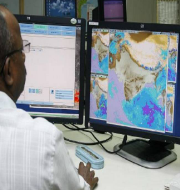South-West Monsoon to be normal: IMD
The India Meteorological Department’s (IMD) has predicted a normal monsoon this year with a rainfall of 96% of the long-period average (LPA). Rainfall between 96% and 104% of LPA is considered as normal. The country had to suffer back-to-back droughts in 2014 and 2015. In 2016, rainfall received was 3% less than the 89 cm average despite IMD’s prediction of ‘above normal’ rains. IMD will come up with the regional forecasts in early June.
Reason
The IMD has attributed the projection to a weakening of El Niño and a positive Indian Ocean Dipole (IOD). Weakening of El Nino and positive IOD conditions are expected to be favourable for a normal monsoon.
The El Nino is characterised by a warming of sea surface temperature along the equatorial Pacific Ocean. El Nino is known to dry up monsoon rains every 6 out of 10 years. The Indian Ocean Dipole (IOD) refers to a swing in the sea surface temperatures in the western and eastern Indian oceans.
Significance
The India Meteorological Department’s (IMD) prediction of a normal monsoon will boost the sentiments of stocks. This will put an end to the almost continuous earnings downgrade witnessed in the markets in recent times. The poor earnings had transformed Indian stocks to be one among the most expensive stocks in the world.
The forecast for normal monsoon is expected to result in three to four per cent growth in farm gross domestic product (GDP). Normal monsoon will help in agricultural production and ease inflationary pressures.
The forecast for normal rains is also beneficial for consumer-oriented sectors such as two-wheelers, FMCG, banking and packaged consumer goods that are the worst hit owing to demonetisation. With an increase in farm and non-farm wages, these sectors are expected to witness growth. Demonetisation prevented these sectors from reaping the benefits of good rains last year.
Other benefits of normal monsoon
- Less drawdown of water from reservoirs and the instances of drinking water crisis will be less.
- Improved power situation owing to more power generated in hydel power projects and usage of fewer pumps for irrigation.
- Less pressure on the RBI to raise interest rates
- Economic growth will get strengthened.
- The occurrence of drought will be less. The need for importing oilseeds and pulses will be less.
IMD forecasts
The IMD was set up in 1875. It produced its first monsoon forecast in 1886 after the famine of the 1870s. The Indian Meteorological Department (IMD) issues forecasts for the country as a whole and five regions.
IMD uses a statistical model that uses historical relationships between rainfall and six to eight predictors such as sea-surface temperatures and southeasterly winds over the Indian ocean etc. IMD also uses the data obtained from radar, observatories, ships, sensors and satellites for forecast predictions. The statistical method was introduced by British in the 1920s.
Last year, IMD announced that it is replacing the statistical method with dynamic model, which is based on a U.S. model tweaked for India. IMD also announced that it is spending $60 million on a new supercomputer to improve the accuracy of Monsoon predictions.
Month: Current Affairs - April, 2017


